How EmoniNail™ Eliminates Nail Fungus
The EmoniNail™ Method and our topical formulation were developed based on the results of hundreds of clinical tests into onychomycosis (commonly known as Nail Fungus) and the ways to beat it.
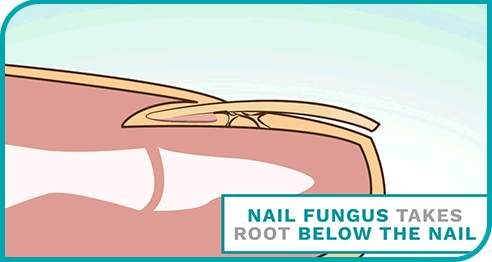
The EmoniNail™ Method Works
The EmoniNail™ Method Works by helping penetrate the nail plate and delivering powerful anti-fungal agents directly into the nail bed where the fungal infection has taken root. (16)
*Clinical Studies have shown preparing and treating the nail as outlined in The EmoniNail™ Method leads to better, faster, complete, and longer-lasting results.
The EmoniNail™ Topical Formulation contains three main fungus-fighting ingredients, each backed by extensive clinical research.
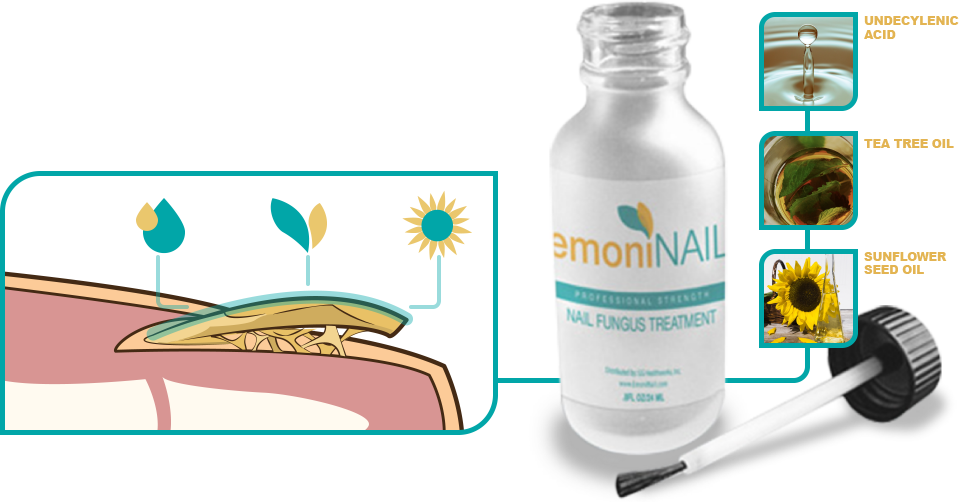 See Complete Product Label >
See Complete Product Label >
EmoniNail works by killing fungus on contact and allowing clear beautiful nails to regrow and replace the old infected nails.


Undecylenic Acid
The group who received undecylenic acid treatment showed significant improvement, as 88% of participants' nail fungus were eliminated after four weeks. (5)
Undecylenic Acid is a US FDA-approved antifungal agent.
Undencylenic acid works by disrupting the growth and multiplication of fungi, including dermatophytes (the most common group of fungi causing fungal nail infections), and yeasts. 2,3,4
In a study of 151 people… the group receiving the undecylenic acid treatment showed significant improvement within just 4 weeks of treatment. ...The fungus was eliminated in 88 percent of the participants after four weeks, compared to only 17 percent of those treated with the placebo powder. (5)
Undecylenic acid belongs to a group of chemical compounds known as “fatty acids” and is found naturally in the body (present in sweat). Commercially, it is obtained from castor oil.1
Undecylenic acid works by disrupting the growth and multiplication of fungi, including dermatophytes (the most common group of fungi causing fungal nail infections), and yeasts. 2,3,4
Multiple clinical trials have evaluated the effectiveness of undecylenic acid in fungal infections. In a study of 151 people with fungal infection of the foot, the participants were randomly assigned to receive a topical powder containing 2% undecylenic acid and 20% zinc
undecylenate (the salt form of undecylenic acid) or a placebo powder. The group receiving the undecylenic acid treatment (active powder) showed significant improvement within just 4 weeks of treatment. In 85 of the participants who were assigned to receive the active powder, the fungal infection was caused by dermatophytes, and the fungus was eliminated in 88 percent of them after four weeks, compared to only 17 percent of those treated with the placebo powder. 5
In another study, 26 diabetic patients with mild, moderate, and severe nail fungal infections went through a new treatment regime. The regime began with a 30-minute warm water soak, followed by filing of the nails, and application of a topical solution containing a cyanoacrylate (a resin) base with 0.1% undecylenic acid and 0.05% hydroquinone. At the end of 3 months, there was a 100% cure rate in patients with mild nail fungal infection (out of 13 patients), 65% cure rate in patients with moderate infection (out of 46 patients), and 35% cure in those with severe nail infection (out of 95 patients).6
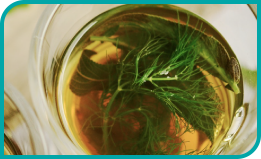
Tea Tree Oil
80% of the participants using the test cream were cured of the fungus, proven by negative fungal tests, while none of the participants in the placebo group achieved cure. (11)
Studies have shown that tea tree oil exhibits antifungal properties both in laboratory conditions and in human studies. (7)(8)(9)(10)
After 4 months of treatment, 80% of the participants using the test cream were cured of the fungus, proven by negative fungal tests, while none of the participants in the placebo group achieved cure (11)
Tea tree oil, also known by its botanical name melaleuca oil, is an essential oil obtained from tea trees. Studies have shown that tea tree oil exhibits antifungal properties both in laboratory conditions and in human studies, particularly against some dermatophytes. 7,8,9,10
In a study of 117 patients with nail fungal infection, the participants were randomized to receive either topical 1% clotrimazole solution (an FDA-approved antifungal agent) or 100% strength tea tree oil for 6 months. At the end of the study, the group receiving topical tea tree oil had cure rates (negative fungal tests in 18% and clinical improvement/resolution in 60% of participants) equal to that of the group receiving the clotrimazole solution (negative fungal tests in 11% and clinical improvement/resolution in 61% of participants). 10
In another study, 60 people with toenail fungal infection were randomized to receive either a cream containing 2% butenafine hydrochloride (an antifungal agent) and 5% tree tea oil or a placebo cream. After 4 months of treatment, 80% of the participants using the test cream were cured of the fungus, proven by negative fungal tests, while none of the participants in the placebo group achieved cure.11 The rate of cure with this treatment was higher than that seen in another study using butenafine without tea tree oil in the same number of patients. 12
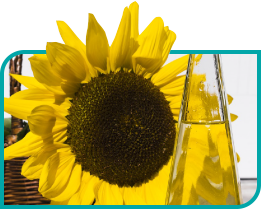
Sunflower Seed Oil
At the end of the study, 90.5% of the participants that received sunflower oil were cured and the rest of them (9.5%) saw clinical improvement. (15)
Studies have shown that sunflower oil has anti-inflammatory effects as well as the ability to repair damaged skin barrier. Sunflower oil is rich in linoleic acid, a type of fat molecule that is present in and is essential for healthy skin, hair, and nails. (13)
There is also evidence that sunflower oil has antifungal activity in nail infection-causing dermatophytes and yeasts, which has been demonstrated in both laboratory conditions and in humans. 14
Sunflower oil is obtained from sunflower seeds. Studies have shown that sunflower oil has anti-inflammatory effects as well as the ability to repair damaged skin barrier. Sunflower oil is rich in linoleic acid, a type of fat molecule that is present in and is essential for healthy skin, hair, and nails. 13
There is also evidence that sunflower oil has antifungal activity in nail infection-causing dermatophytes and yeasts, which has been demonstrated in both laboratory conditions and in humans.14 In one clinical study, 400 patients with nail fungal infection were randomized to receive either topical sunflower oil in ozonized form (where oxygen is added) or 2% ketoconazole cream for 3 months. In the group receiving sunflower oil, improvement was seen within the first month of treatment while the group receiving ketaconazole did not see any results until after the third month. At the end of the study, 90.5% of the participants that received sunflower oil were cured and the rest of them (9.5%) saw clinical improvement. In the ketaconazole group, only 13.5% of patients were cured and 27.5% saw improvement, while the rest had no change. After 3 months, both treatments were stopped and the patients were followed-up after 1 year. In the group that had received sunflower oil, 97.2% remained fungus-free, while only about half of the patients in the ketoconazole group were still fungus-free. 15
The EmoniNail™ Method
When using topical antifungal treatments, the key to success is to increase the exposure of the fungus to the treatment as much as possible. There is evidence showing that soaking the nails in warm water, followed by clipping and/or filing down the nails leads to better results from topical treatments than when these steps are not followed. 6,15
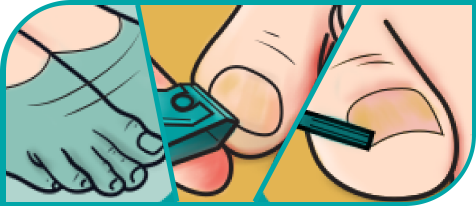

Soaking the nails in warm water cleans and softens the nails, while clipping and filing the nails clears parts of the affected nail and helps the topical treatment get to the nail bed where the fungus lives. Following these measures along with regular, continuous treatment with a potent topical agents, like those found in EmoniNail, is an important recipe for the cure of fungal nail infections.
*Clinical studies have shown preparing and treating the nail as outlined in The EmoniNail™ Method leads to better, faster, more complete, and more long-lasting results.
Restore Clear Nails with EmoniNail™
-
 Kills Nail Fungus
Kills Nail Fungus -
 Applies Easily with Topical Brush
Applies Easily with Topical Brush -
 Helps Clear Yellow Keratin
Helps Clear Yellow Keratin -
 Natural, Safe and Effective
Natural, Safe and Effective
-
 Unlimited Access to Treatment Support Experts
Unlimited Access to Treatment Support Experts
-
 Guaranteed to Work within 60 Days or Your Money Back
Guaranteed to Work within 60 Days or Your Money Back
-
 It Works
It Works


Reviewed and writing contributions by
Dr. Rohanti Ravikulan
Bachelor of Medicine Bachelor of Surgery (MBBS)1.Undecylenic Acid. Monograph. (2002). Alternative Medicine Review, [online] 7(1). Available at: http://archive. foundationalmedicinereview.com/publications/7/1/68.pdf
2.McLain N, Ascanio R, Baker C, Strohaver RA, Dolan JW. Undecylenic acid inhibits morphogenesis of Candida albicans. Antimicrob Agents Chemother. 2000;44(10):2873–2875. doi:10.1128/aac.44.10.2873-2875.2000
3.Li, X., Jacob, M., Khan, S., Ashfaq, M., Babu, K., Agarwal, A., ElSohly, H., Manly, S. and Clark, A. (2008). Potent In Vitro Antifungal Activities of Naturally Occurring Acetylenic Acids. Antimicrobial Agents and Chemotherapy, 52(7), pp.2442-2448.
4.Amsel, L., Cravitz, L., Vanderwyk, R. and Zahry, S. (1979). Comparison of In Vitro Activity of Undecylenic Acid and Tolnaftate against Athlete’s Foot Fungi. Journal of Pharmaceutical Sciences, 68(3), pp.384-385.
5.Chretien, J., Esswein, J., Sharpe, L., Kiely, J. and Lyddon, F. (1980). Efficacy of Undecylenic Acid–Zinc Undecylenate Powder in Culture Positive Tinea Pedis. International Journal of Dermatology, 19(1), pp.51-54.
6.Rehder, P. and Nguyen, T. (2008). Clinical Research: A New Concept in the Topical Treatment of Onychomycosis With Cyanoacrylate, Undecylenic Acid, and Hydroquinone. Foot & Ankle Specialist, 1(2), pp.93-96.
7.Homeyer, D., Sanchez, C., Mende, K., Beckius, M., Murray, C., Wenke, J. and Akers, K. (2015). In Vitro activity of Melaleuca alternifolia (tea tree) oil on filamentous fungi and toxicity to human cells. Medical Mycology, 53(3), pp.285-294.17
8.Flores, F., de Lima, J., Ribeiro, R., Alves, S., Rolim, C., Beck, R. and da Silva, C. (2013). Antifungal Activity of Nanocapsule Suspensions Containing Tea Tree Oil on the Growth of Trichophyton rubrum. Mycopathologia, 175(3-4), pp.281-286.
9.Inouye S, Uchida K, Yamaguchi H. In-vitro and in-vivo anti-Trichophyton activity of essential oils by vapour contact. Mycoses. 2001;44(3-4):99-107. doi:10.1046/j.1439-0507.2001.00618.x
10.Buck D, Nidorf D, Addino J. Comparison of two topical preparations for the treatment of onychomycosis: Melaleuca alternifolia (tea tree) oil and clotrimazole. Journal of Family Practice. 1994;38(6). https://go.gale.com/ps/anonymous?id=GALE%7CA15531820.
11.Syed T, Qureshi Z, Ali S, Ahmad S, Ahmad S. Treatment of toenail onychomycosis with 2% butenafine and 5% Melaleuca alternifolia (tea tree) oil in cream. Tropical Medicine and International Health. 1999;4(4):284-287. doi:10.1046/j.1365-3156.1999.00396.x
12.Syed T, Ahmadpour O, Ahmad S, Shamsi S. Management of Toenail Onychomycosis with 2% Butenafine and 20% Urea Cream: A Placebo-controlled, Double-blind Study. J Dermatol. 1998;25(10):648-652. doi:10.1111/j.1346-8138.1998.tb02474.x
13.Lin TK, Zhong L, Santiago JL. Anti-Inflammatory and Skin Barrier Repair Effects of Topical Application of Some Plant Oils. Int J Mol Sci. 2017;19(1):70. Published 2017 Dec 27. doi:10.3390/ijms19010070
14.Guerrer LV, Cunha KC, Nogueira MC, Cardoso CC, Soares MM, Almeida MT. "In vitro" antifungal activity of ozonized sunflower oil on yeasts from onychomycosis. Braz J Microbiol. 2012;43(4):1315–1318. doi:10.1590/S1517-838220120004000011
15.Gupta A, Paquet M. Improved efficacy in onychomycosis therapy. Clin Dermatol. 2013;31(5):555-563. doi:10.1016/j.clindermatol.2013.06.010
16.Westerberg D, Voyack M. Onychomycosis: Current Trends in Diagnosis and Treatment. Am Fam Physician. 2013;88(11).
https://www.aafp.org/afp/2013/1201/p762.html. Accessed November 27, 2019.

















